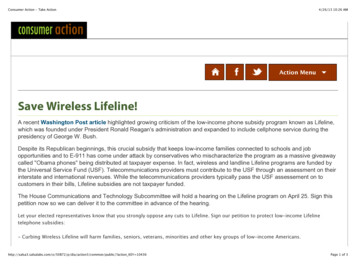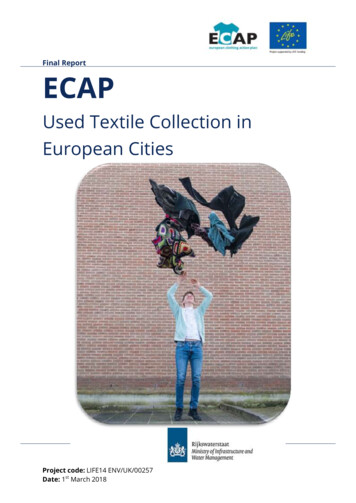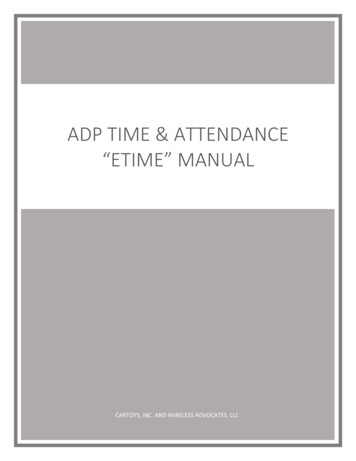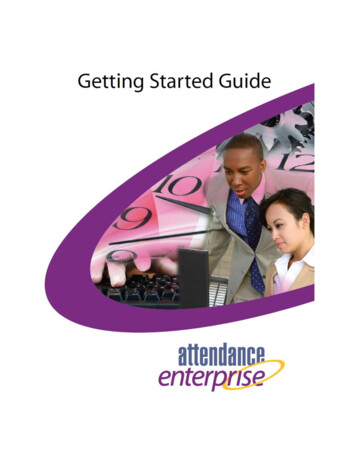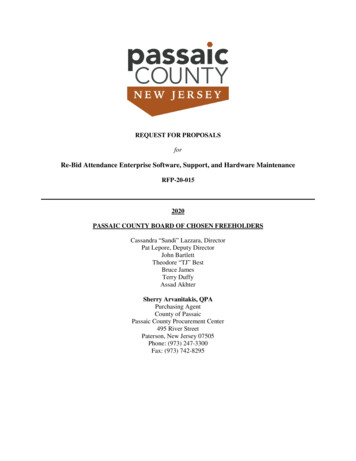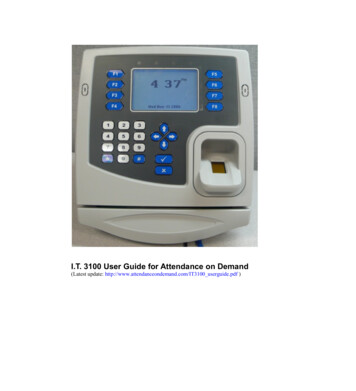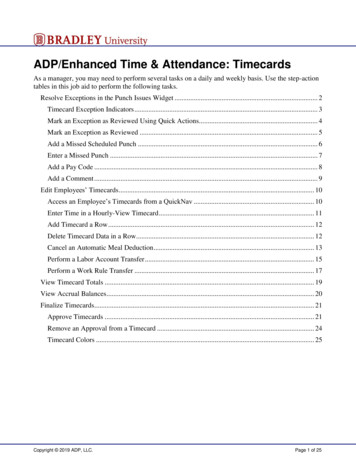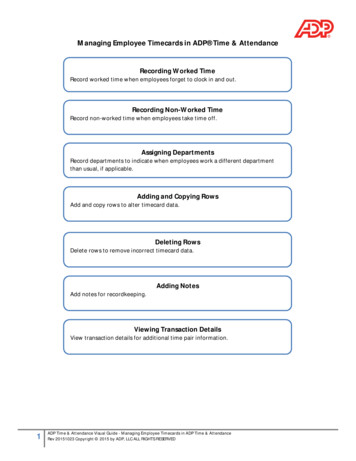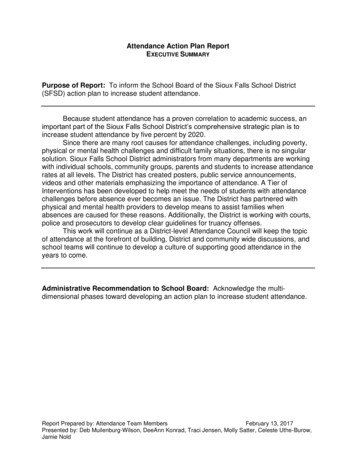
Transcription
Attendance Action Plan ReportEXECUTIVE SUMMARYPurpose of Report: To inform the School Board of the Sioux Falls School District(SFSD) action plan to increase student attendance.Because student attendance has a proven correlation to academic success, animportant part of the Sioux Falls School District’s comprehensive strategic plan is toincrease student attendance by five percent by 2020.Since there are many root causes for attendance challenges, including poverty,physical or mental health challenges and difficult family situations, there is no singularsolution. Sioux Falls School District administrators from many departments are workingwith individual schools, community groups, parents and students to increase attendancerates at all levels. The District has created posters, public service announcements,videos and other materials emphasizing the importance of attendance. A Tier ofInterventions has been developed to help meet the needs of students with attendancechallenges before absence ever becomes an issue. The District has partnered withphysical and mental health providers to develop means to assist families whenabsences are caused for these reasons. Additionally, the District is working with courts,police and prosecutors to develop clear guidelines for truancy offenses.This work will continue as a District-level Attendance Council will keep the topicof attendance at the forefront of building, District and community wide discussions, andschool teams will continue to develop a culture of supporting good attendance in theyears to come.Administrative Recommendation to School Board: Acknowledge the multidimensional phases toward developing an action plan to increase student attendance.Report Prepared by: Attendance Team MembersFebruary 13, 2017Presented by: Deb Muilenburg-Wilson, DeeAnn Konrad, Traci Jensen, Molly Satter, Celeste Uthe-Burow,Jamie Nold
Attendance Action Plan ReportPurpose of Report: To inform the school board of the Sioux Falls School District (SFSD)action plan to increase student attendance.District Priority Area: School Culture and ClimatePriority State 3: Sioux Falls School District will provide a nurturing and safe learningexperience for all.Annual Objective: SI2.3-1: Research and outline an action plan to address increasing studentattendance.Explanation:Overview: Consistent school attendance has a positive correlation to academic success andschool completion as outlined in SFSD Policy JH, Student Attendance, and through research.Ten or more absences in a school year is excessive as defined in the policy. Emerging from theDistrict strategic planning process of reviewing data, listening to stakeholders, and actionabledialogue to improve the District was a goal to improve attendance. A specific and quantifiablegoal has been developed to serve as a metric to monitor District progress in this area:By 2020, the number of K-8 students who did not attend school at least 94% of the timewill decrease by 5%.Baseline data from the 2015-2016 school year documents 3,607 students did not meet the goalto attend school at least 94% of the time. The overall attendance rate across the SFSD was94.35% during 2015-2016 school year.The South Dakota School Performance Index (SPI) is calculated for each SD school district andincludes an attendance data point with the changes implemented during summer 2016. As aresult of the revision to SFSD Policy JH in June 2016, District and building leaders reviewed themarking of attendance to ensure consistent practices in data entry systems and codes for the2016-2017 school year. The Informational Technology Services department has developedsystems to make attendance data readily accessible for building attendance teams to accessand monitor.The attendance committee began by reviewing data in an effort to better understand the rootcauses of students with excessive absenteeism and the barriers to regular attendance in theSFSD. Although there is no one pattern or root cause for all students with attendancechallenges, the impact of poverty rates, physical and mental health challenges, and difficultfamily situations are factors that influence school attendance. Consistent with national trends,SFSD students who identify ethnically/racially as Native American or Black or students withdisabilities have higher absenteeism rates than their peers. After review, the committeeconcluded that processes the SFSD develops to improve attendance need to be focused onlearning about, and problem-solving around, the individual circumstances of the impactedstudent and the interventions personalized for that individual.Raise awareness of the importance of school attendance: The District started a campaign inAugust 2016 titled, “Attendance Matters. Every Student. Every Day.” Raising awareness ofstudents, parents, staff and the community regarding the importance of school attendance wasthe goal of the campaign. The Office of Community Relations launched the multifacetedawareness campaign, producing “Attendance Matters” posters for school buildings, creatingPrepared by Attendance Team Members1February 13, 2017Presented by: Deb Muilenburg-Wilson, DeeAnn Konrad, Traci Jensen, Molly Satter, Celeste UtheBurrow, Jamie Nold
public service announcements for use by local media, developing videos to showcase schoolspecific attendance projects, and supporting other needs brought forth by principals.https://www.youtube.com/watch?v h uB7dmlcCwhttps://www.youtube.com/watch?v OPOiuD8oK3MMidcontinent and KTTW cable channels provided free air time. In December 2016, the Districtwas chosen as a Tradition of Caring Award Winner by KELOLand TV, resulting in 17,000 offree airtime and website presence to further inform the community about the importance ofschool attendance. The SFSD-produced television spots will air during critical times whenschool attendance has historically taken a dip.Tiers of Intervention for schools: The study committee reviewed researched, effective strategiesand surveyed SFSD building principals to begin the development of a multi-tiered system ofsupports that combine prevention with early and consistent interventions as determined byanalyzing individual students’ needs. At the base of the tiers are general SFSD procedures thatwill be implemented Districtwide to communicate and document attendance challenges.Appendix A contains the beginning SFSD tiers of attendance intervention model.In this “tiered” model, every student has access to the first tier of supports, with additionalinterventions becoming available if what has been provided is not sufficient to improve theirattendance. The second tier includes interventions that are individualized to the student toeither alleviate or eliminate the barriers to regular school attendance. In this level, buildingattendance teams are implementing a problem-solving approach to understand the individualstudent and parent circumstances which are interfering in school attendance. Interventionsintensify as you move to the third tier. At this level in the tiers, the building attendance teammay be coordinating resources from both school and community entities.Never static, the matrix will continue to be expanded to add interventions as further strategiesare reviewed and SFSD systems are developed for building attendance teams to implement.As a support to building teams, Student Support Services will develop a resource list ofreviewed materials and web links regarding the effective implementation of the interventions.Community partnerships and dialogue: The SFSD recognizes and embraces that helpingschools, families and students overcome the barriers for getting students to school is not amatter for schools in isolation. It requires a community including schools, public officials, publicagencies, businesses, families and youth to work together toward the goal to increase studentattendance. Since September of 2016, the SFSD has initiated dialogue with the followingcommunity partners toward that goal.--Dialogue with community health partners: In December 2016, select SFSD administrators metwith Avera McGreevy and Sanford Health clinic administrators to discuss medicaldocumentation and attendance regarding student absences that are health related. The SFSDrecognizes the importance of accommodating students with special health needs as well as theimportance of students staying home when they are ill and/or contagious. Health care providersPrepared by Attendance Team Members2February 13, 2017Presented by: Deb Muilenburg-Wilson, DeeAnn Konrad, Traci Jensen, Molly Satter, Celeste UtheBurrow, Jamie Nold
play an important role in determining a student’s health status and when they can return toschool. Medical documentation is often the means of communication between the health careprovider and the school. During our conversation both healthcare systems voiced a desire tolearn more about the health services we are able to provide to students. They also requested areturn to school letter template outlying the information needed to document student healthrelated absences. In January 2017, a health services brochure and a return to school lettertemplate were developed and provided to the healthcare systems. Both entities have pledged toprovide the information and letter template to their health care providers. We are hopeful thatthese interventions and ongoing communication will positively impact student attendance.--Dialogue with community mental health supports: Southeastern Behavioral Health (SEBH)provides home and school-based services and has assigned counselors in schools across thecity. This partnership allows SEBH to work with families on identifying problem areas that causea disruption in a child’s ability to regularly attend school. In addition, the counselors work withstaff members of the SFSD to develop programming and communication with the student andfamily that is consistent and solution focused. SEBH along with Lutheran Social Services (LSS)are authorized by the state to provide services in the areas of Family Functional Therapy (FFT)and Dialectical Behavior Therapy (DBT). Both of these services are researched based and havebeen proven to assist individuals with overcoming mental health issues that impede their abilityto perform at home and school. Several local mental health providers have partnered with theSFSD to assist students and families that have mental health challenges that impede theirability to attend school regularly.Washington High School has implemented a pilot program with SEBH, Graduate on TimeProgram (GOT), that utilizes Southeastern counselors to assist students and families witheliminating barriers and addressing issues that prevent students from graduating on time. Thestudents selected for the GOT program are juniors in high school that are behind their cohort ineither credits or completing coursework in time to graduate. They have different challenges thatthe SEBH counselors work to identify and address in an effort to increase attendance, creditattainment and overall wellbeing. Currently there are 20 students being served in the programwith a goal of 40 students by graduation of the 2018 school year.--Dialogue with SFSD, 2nd Judicial Circuit Court, SFSD Police Department, and MinnehahaCounty Juvenile States Attorney: In 2015, Senate Bill 73 was passed into law. Senate Bill 73was the Juvenile Justice Reinvestment Initiative. This law overhauled the juvenile justicesystem and significantly changed the truancy process. The law also expanded local communitybased programs aimed at assisting youth and reducing recidivism. Truancy became a citableoffense that required a court appearance by the offending juvenile. The citation process is anattempt to deter absenteeism at a lower level in the juvenile courts to avoid the formal probationprocess for our youth. The creation of the Truancy Based Interventions process was acollaborative effort that included numerous individuals from the SFSD, the States Attorney, the2nd Judicial Circuit, School Resource Officers, social workers, JDAI administrators, stateemployees and several others. The result of this collaborative work was the Truancy BasedInterventions (Appendix B). The Truancy Based Interventions process will provide schoolpersonnel and truancy officers with distinct guidelines to follow when determining if an act oftruancy should be cited as an offense. The process does not work in isolation, but as one partof the overall pyramid of interventions for improved attendance.Prepared by Attendance Team Members3February 13, 2017Presented by: Deb Muilenburg-Wilson, DeeAnn Konrad, Traci Jensen, Molly Satter, Celeste UtheBurrow, Jamie Nold
Ongoing process: The study committee has outlined an ongoing District process to continue tokeep the SFSD and community partners focused on improving student attendance. A Districtlevel “Attendance Council” of stakeholders will meet quarterly. This council will keep attendanceat the forefront of building, district and community wide discussions to: Ensure current partnership dialogues continueNetwork to expand to other partnerships in the community to support student attendanceExplore further researched interventions to add to the intervention tiersPursue further information from other school districts that have improved regular schoolattendanceAnalyze data to monitor attendance trends and changes across the SFSDProvide research based resources to building attendance teams through a bi-annualnewsletterEach school building attendance team will: Lead the school in developing school attendance initiatives, processes and goalsReview building attendance dataIdentify students needing supports and provide individualized interventionsMonitor ongoing attendance at the school level.Costs: Not applicableCommittee Participation: The District study committee includes 6 elementary, middle andhigh school principals, 3 social workers, 3 nurses, specialized programs supervisor, Joe FossAlternative School Program Supervisor, 2 school counselors, Health Services Supervisor,Community Education Supervisor, Student Services Coordinator, and Special Services Director.In addition, subgroups of District staff and community partners continue dialogue to support theimproving the attendance initiative.Summary: The SFSD believes that increasing student attendance will positively correlate toincreased student learning and graduation. Progress toward improving student attendance inschools will only be made if districts, schools and partners fully recognize that the collectiveaction of a whole community will have the most impact. The public campaign will continue toraise awareness of the importance of attendance. An ongoing process has been developed aspart of the action plan which includes each school building having an attendance team thatmeets to monitor building attendance data, implement interventions based on individual studentneeds and lead building initiatives to enhance attendance. At the District level, an attendancecouncil will be put in place to lead ongoing districtwide conversations and research additionalinterventions to expand the tiered system with resources for building attendance teams.Ongoing community dialogue and partnerships will occur to support students and families toimprove attendance at school.Administrative Recommendation to the School Board: Acknowledge the multi-dimensionalphases toward developing an action plan to address increasing student attendance.Prepared by Attendance Team Members4February 13, 2017Presented by: Deb Muilenburg-Wilson, DeeAnn Konrad, Traci Jensen, Molly Satter, Celeste UtheBurrow, Jamie Nold
Attendance Interventions: District-WideTier 5Tier 4Tier 3Tier 2Tier 102/09/2017-Recommendation to States Attorney’s office:Failure to Send/Ticket-Student enrollment dropped after 15 consecutive days of absence-Refer students and/or families to community resources that target theindividualized need(s) of the student.-Notify parent/guardian of the possibility of rescinding an open enrollment due to attendance concerns-Notification letter sent to parent/guardian concerning the potential of student enrollment being droppedafter 15 consecutive days of absences-Home visit by a social worker, principal, and/or other school personnel *Middle School/High School-Recommendation to the School Resource Officer: Citation 2 *Middle School/High School-Administrator, social worker, and/or school designee contact parent/guardian-Home visit by a social worker, principal, and/ or other school personnel *Elementary School-School counselor contact the parent/guardian-Release for the school nurse to communicate with the doctor-Attendance agreement between parent, school, and/or student-504/Student Assistance Team (SAT) referral-Behavior Attendance and Social Emotional (BASE) team referral *Elementary School-Connect student with a support person (staff member or mentor)-Connect student and/or family with community and school resources-Altering make-up work completion dates/student schedule *Middle School/High School-Recommendation to the School Resource Officer: Citation 1 *Middle School/High School-Classroom, building, District-wide goals for attendance-Teacher conversations with parents/student-Students tracking own attendance in the classroom *Elementary School-English Language Learner Liaison/Native American Liaison contacting parent/guardian-School nurse contacts parent/guardian when student is absent due to health related concerns-Highlight the importance of attendance at parent/teacher conferences-Incentives: Classroom, building, District-wide-Referral to school counselor-Student spending time after school to make-up time and/or work *Elementary/Middle School-Communication with the probation officer if student has been assigned-Facilitate positive relationships that foster student engagement to promote regular attendanceProcedures-5 and 8 day attendance letters sent home-Attendance Response Team-Notes on report cards concerning attendance-Attendance secretary calls the home concerning attendance-Inquiring about a student’s health-Attendance flags on the Parent Portal-Attendance committee meetings-Post attendance data by grade/school-District-wide attendance campaign-Recognition of perfect attendance-Highlight attendance in the newsletters-District-wide message: AttendanceMattersThe Sioux Falls School District is committed to providing a school climate and culture that supports and encouragesstudent attendance.
TRUANCY BASED INTERVENTIONS(Implemented January 23, 2017)Procedures jointly developed by the Sioux Falls School District 49-5 / 2nd Judicial Circuit / SiouxFalls Police Department and Minnehaha County Juvenile States AttorneyThe Sioux Falls School District will continue to implement and carry out additional programmingand services to increase the attendance of all students. The following steps are those related tothe citation process, and programming specific to truant students and their parents/guardians.Step 1: Five to Eight Days of Absence: All absences included1. The school district will send a letter to the parent/guardian of the student and documentin the Infinite Campus (“IC”) Contact Log.a. Include consequences for lack of attendance.b. Include number of days absent.2. The school district will make a telephone or in-person contact with student andparent/guardian from at least one school official and document in the IC Contact Log. Aschool official will include the following: a social worker, truancy officer, successcoordinator, counselor, administrator or the designee of an administrator. If multipleattempts to contact parents/guardians are unsuccessful, the attempts will bedocumented in the IC Contact Log.3. The School District will start the Pyramid of Interventions specific to attendance, andwhen appropriate, will offer additional programming to assist the student/family, andoffer options to avoid truancy citations such as community
Midcontinent and KTTW cable channels provided free air time. In December 2016, the District was chosen as a Tradition of Caring Award Winner by KELOLand TV, resulting in 17,000 of free airtime and website presence to further inform the community about the importance of school attendance.
